The Inverse Laplace Transform by Partial Fraction Expansion
Contents
This technique uses Partial Fraction Expansion to split up a complicated
fraction into forms that are in the Laplace Transform table.
As you read through this section, you may find it helpful to refer to the
review section on partial fraction
expansion techniques. The text below assumes you are familiar with
that material.
Consider first an example with distinct real roots.
Example: Distinct Real Roots
See this problem solved with MATLAB
Find the inverse Laplace Transform of:

Solution:
We can find the two unknown coefficients using the "cover-up" method.
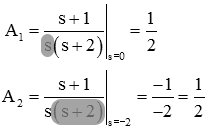
So

and

(where U(t) is the ) or expressed another way

The last two expressions are somewhat cumbersome.
Unless there is confusion about the result, we will assume that all of our
results are implicitly 0 for t<0, and we will write the result as

Consider next an example with repeated real roots (in
this case at the origin, s=0).
Example: Repeated Real Roots
See this problem solved with MATLAB
Find the inverse Laplace Transform of the function F(s).

Solution:
We can find two of the unknown coefficients using the "cover-up" method.
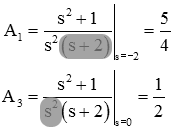
We find the other term using cross-multiplication:

Equating like powers of "s" gives us:
| power of "s" |
Equation |
| s2 |
 |
| s1 |
 |
| s0 |
 |
We could have used these relationships to determine A1,
A2, and A3. But A1 and A3 were easily found using the "cover-up"
method. The top relationship tells us that A2=-0.25, so

and

(where, again, it is implicit that f(t)=0 when t<0).
Many texts use a method based upon differentiation of the fraction when there
are repeated roots. The technique involves differentiation of ratios of
polynomials which is prone to errors. Details are
here if you are interested.
Another case that often comes up is that of complex conjugate roots.
Consider the fraction:

The second term in the denominator cannot be factored into real terms.
This leaves us with two possibilities - either accept the complex roots, or
find a way to include the second order term.
Example: Complex Conjugate Roots (Method 1)
Using the complex (first order) roots
Simplify the function F(s) so that it can be looked up in the Laplace Transform table.

Solution:
If we use complex roots, we can expand the fraction as we did before.
This is not typically the way you want to proceed if you are working by
hand, but may be easier for computer solutions (where complex numbers are
handled as easily as real numbers). To perform the expansion, continue
as before.

where
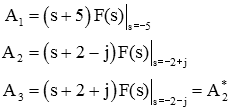
Note that A2 and A3 must be complex conjugates of each
other since they are equivalent except for the sign on the imaginary part.
Performing the required calculations:
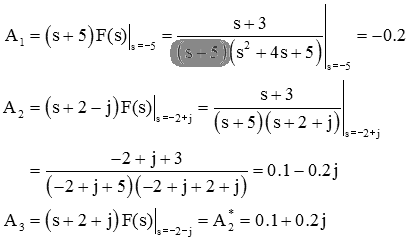
so

The inverse Laplace Transform is given below (Method 1).
Example: Complex Conjugate Roots (Method
2)
Method 2 - Using the second order polynomial
Simplify the function F(s) so that it can be looked up in the Laplace Transform table.

Solution:
Another way to expand the fraction without resorting to complex numbers
is to perform the expansion as follows.

Note that the numerator of the second term is no longer
a constant, but is instead a first order polynomial. From above (or using the
cover-up method) we know that A=-0.2. We can find the quantities B and
C from cross-multiplication.
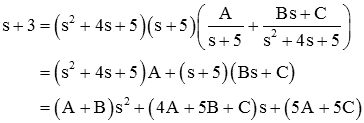
If we equate like powers of "s" we get
order of
coefficient |
left side
coefficient |
right side
coefficient |
| 2nd (s2) |
0 |
A+B |
| 1st (s1) |
1 |
4A+5B+C |
| 0th (s0) |
3 |
5A+5C |
Since we already know that
A=-0.2, the first expression (0=A+B) tells us that B=0.2, and
the last expression (3=5A+5C) tells us that C=0.8. We can use
the middle expression (1=4A+5B+C) to check our calculations.
Finally, we get

The inverse Laplace Transform is given below (Method 2).
The two previous examples have demonstrated two techniques for
performing a
partial fraction expansion of a term with complex roots.
The first technique was a simple extension of the rule for
dealing with distinct real roots. It is conceptually
simple, but can be difficult when working by hand because of the
need for using complex numbers; it is easily done by computer.
The second technique is easy to do by hand, but is conceptually
a bit more difficult. It is easy to show that the two
resulting partial fraction representations are equivalent to each other.
Let's first examine the result from Method 1 (using two techniques).
We start with Method 1 with no particular simplifications.
Method 1 - brute force technique
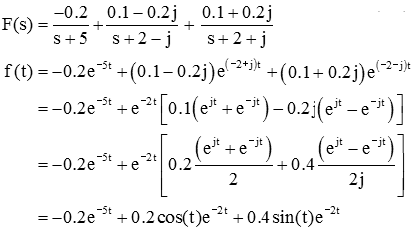
(The last line used Euler's identity for cosine and sine)
We now repeat this calculation, but in the process we develop a general
technique (that proves to be useful when using MATLAB to help with the
partial fraction expansion. We know that F(s) can be represented as a
partial fraction expansion as shown below:
Method 1 - a more general technique

We know that A2 and A3 are
complex conjugates of each other:

Let

We can now find the inverse
transform of the complex conjugate terms by treating them as
simple first order terms (with complex roots).
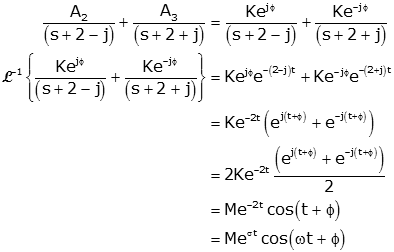
In this expression M=2K. The frequency (ω)
and decay coefficient (σ) are determined from the root of the denominator of A2 (in this
case the root of the term is at s=-2+j; this is where the term is equal to
zero). The frequency is the
imaginary part of the root (in this case, ω=1), and the decay coefficient is the real part of the root (in this case,
σ=-2).
Using the cover-up method (or, more likely, a
computer program) we get

and

This yields

It is easy to show that the
final result is equivalent to that previously found, i.e.,

While this method is somewhat
difficult to do by hand, it is very convenient to do by
computer. This is the approach used on the page that shows MATLAB techniques.
Finally we present Method 2, a technique that is easier to work with
when solving problems for hand (for homework or on exams) but is less useful
when using MATLAB.
Method 2 - Completing the square
Review
of procedure for completing the square.
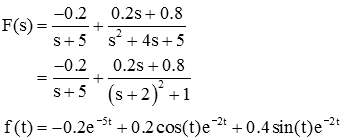
(The last line used the entry "generic decaying oscillatory" from Laplace Transform Table)
Thus it has been shown that the two
methods yield the same result. Use Method 1 with MATLAB and use Method 2
when solving problems with pencil and paper.
Example - Combining multiple expansion methods
Find the inverse Laplace Transform of

Solution:
The fraction shown has a second order term in the denominator that
cannot be reduced to first order real terms.
As discussed in the page describing partial
fraction expansion, we'll use two techniques. The
first technique involves expanding the fraction while retaining the second order
term with complex roots in the denominator. The second technique
entails "Completing the Square."

Since we have a repeated root, let's cross-multiply
to get

Then equating like powers of s
| Power of s |
Equation |
| s3 |
0=A1+B |
| s2 |
5=2A1+A2+C |
| s1 |
8=5A1+2A2 |
| s0 |
-5=5A2 |
Starting at the last equation

So

The last term is not quite in the form that
we want it, but by completing the square we get

Now all of the terms are in forms that are
in the Laplace
Transform Table (the last term is the entry "generic decaying
oscillatory").

Example - Repeat Previous Example, Using Brute Force
See this problem solved with MATLAB
We repeat the previous example, but use a brute force technique.
You will see that this is harder to do when solving a problem manually,
but is the technique used by MATLAB. It is important to be able to
interpret the MATLAB solution.
Find the inverse Laplace Transform of

Solution:
We can express this as four terms, including two complex terms (with A3=A4*)

Cross-multiplying we get (using the fact that
(s+1-2j)(s+1+2j)=(s2+2s+5))

Then equating like powers of s
| Power of s |
Equation |
| s3 |
0=A1+A3+A4 |
| s2 |
5=2A1+A2+(1+2j)A3+(1-2j)A4 |
| s1 |
8=5A1+2A2 |
| s0 |
-5=5A2 |
We could solve by hand, or use MATLAB:
>> A=[1 0 1 1; 2 1 1+2j 1-2j; 5 2 0 0; 0 5 0 0];
>> b=[0 5 8 -5]';
>> inv(A)*b
ans =
2.0000
-1.0000
-1.0000 - 1.0000i
-1.0000 + 1.0000i
So,

and

We will use the notation derived above (Method 1 - a more general technique).
The root of the denominator of the A3 term in the partial
fraction expansion is at s=-1+2j (i.e., the denominator goes to 0 when
s=-1+2j), the magnitude of A3 is √2, and the angle of A3
is 225°. So, M=2√2, φ=225°,
ω=2, and σ=-1. Solving for f(t) we get

This expression is equivalent to the one obtained
in the previous example.
When the Laplace Domain Function is not strictly proper (i.e., the order of
the numerator is different than that of the denominator) we can not immediatley
apply the techniques described above.
Example: Order of Numerator Equals Order of Denominator
See this problem solved with MATLAB
Find the inverse Laplace Transform of the function F(s).

Solution:
For the fraction shown below, the order of the numerator polynomial is not
less than that of the denominator polynomial, therefore we first perform long division

Now we can express the fraction as a constant plus a ratio of polynomials.

Using the cover up method
to get A1 and A2 we get

so

The last case we will consider is that of exponentials in the numerator of
the function.
Example: Exponentials in the numerator
Find the inverse Laplace Transform of the function F(s).

Solution:
The exponential terms indicate a time delay
(see the time delay property).
The first thing we need to do is collect terms that have the same time
delay.

We now perform a partial fraction expansion for each
time delay term (in this case we only need to perform the expansion for the
term with the 1.5 second
delay), but in general you must do a complete expansion for each term.

Now we can do the inverse Laplace Transform of each term
(with the appropriate time delays)

References
Replace





















































